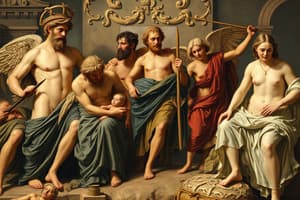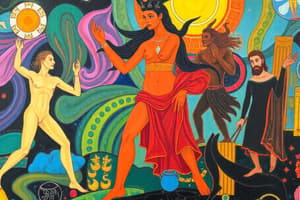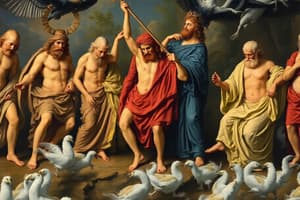Podcast
Questions and Answers
The Parthenon was dedicated to the goddess ______.
The Parthenon was dedicated to the goddess ______.
Athena
The Erechtheion features ______, which are female figures used as columns.
The Erechtheion features ______, which are female figures used as columns.
Caryatids
The ______ columns are columns around the temple.
The ______ columns are columns around the temple.
Peristyle
The Temple of Athena Nik has ______ columns.
The Temple of Athena Nik has ______ columns.
The Birth of Athena shows the birth of goddess Athena from the head of her father ______.
The Birth of Athena shows the birth of goddess Athena from the head of her father ______.
The ______ may be victors of the Torch race.
The ______ may be victors of the Torch race.
______ is a lost wax technique used in bronze sculptures.
______ is a lost wax technique used in bronze sculptures.
______ is oxidation of copper or bronze making a green rust.
______ is oxidation of copper or bronze making a green rust.
The ______ has wires that were supposed to be leashes for Gilt horses.
The ______ has wires that were supposed to be leashes for Gilt horses.
Archaeologists thought the ______ would've held a trident.
Archaeologists thought the ______ would've held a trident.
The ______ uses a wood stump for support so the statue doesn't fall.
The ______ uses a wood stump for support so the statue doesn't fall.
______ was the Perfect male body.
______ was the Perfect male body.
The ______ shows Hegeso passing on knowledge to her daughter.
The ______ shows Hegeso passing on knowledge to her daughter.
The ______ was discovered in the temple of Hera.
The ______ was discovered in the temple of Hera.
The ______ was ment to be in a niche - a cutout in the wall to put sculptures.
The ______ was ment to be in a niche - a cutout in the wall to put sculptures.
______ had leaves at the top of column.
______ had leaves at the top of column.
Half of the columns are smoothed on the ______.
Half of the columns are smoothed on the ______.
The ______ showed enemies not to mess with the Greeks.
The ______ showed enemies not to mess with the Greeks.
The ______ was taken from a Boat carved out of mountain.
The ______ was taken from a Boat carved out of mountain.
The ______ showed complex emotions in sculptures.
The ______ showed complex emotions in sculptures.
Flashcards
Parthenon Definition
Parthenon Definition
A temple dedicated to Athena, built in Acropolis, Athens, by Ictinus and Callicrates between 447-432 B.C. Only priests were allowed inside.
Temple of Athena Nike
Temple of Athena Nike
A small temple in Acropolis, Athens, dedicated to Athena and Nike, dating back to c. 426 B.C., with prostyle and Peristyle columns.
Erechtheion Definition
Erechtheion Definition
A temple in Acropolis, Athens, dating back to c. 421-405 B.C., known for its Caryatid: female figures used as columns with functional drapery.
Birth of Athena
Birth of Athena
Signup and view all the flashcards
Frieze of Jar Carriers
Frieze of Jar Carriers
Signup and view all the flashcards
Athena Parthenos
Athena Parthenos
Signup and view all the flashcards
Bronze Poseidon
Bronze Poseidon
Signup and view all the flashcards
Discobolus
Discobolus
Signup and view all the flashcards
Doryphorus
Doryphorus
Signup and view all the flashcards
Hermes & Infant Dionysius
Hermes & Infant Dionysius
Signup and view all the flashcards
Aphrodite of Knidos
Aphrodite of Knidos
Signup and view all the flashcards
Temple of Olympian Zeus
Temple of Olympian Zeus
Signup and view all the flashcards
Stoa of Attalos
Stoa of Attalos
Signup and view all the flashcards
Altar of Zeus
Altar of Zeus
Signup and view all the flashcards
Laocoon
Laocoon
Signup and view all the flashcards
Study Notes
Greek Art - Classical Period (480 - 431 B.C.)
- Key artworks from this period are described
Parthenon
- Built between 447-432 B.C.
- Located on the Acropolis in Athens, Greece
- Designed by architects Ictinus and Callicrates
- Only priests were allowed to enter
- Dedicated to the goddess Athena
- Was blown up at some point in history
Temple of Athena Nik
- Dates back to approximately 426 B.C.
- Located on the Acropolis in Athens, Greece
- Designed by architect Callicrates
- Features prostyle columns (columns in the front)
- Features Peristyle columns (columns surrounding the temple)
- Dedicated to the goddesses Athena and Nike
Erechtheion
- Dates back to approximately 421-405 B.C.
- Located on the Acropolis in Athens, Greece
- Designed by architect Mnesicles
- Features Caryatids, which are female figures used as columns
- Female figures incorporate functional drapery
- Housed several cults, including those of Poseidon, Athena, and Erechtheus
Birth of Athena
- Dates back to approximately 445 B.C.
- Features High relief
- Pediments have been damaged due to natural disasters, fire, religious conflicts, weathering, and pollution
- Depicts the birth of the goddess Athena from the head of her father Zeus
Frieze of Jar Carriers
- Dates back to approximately 440 B.C.
- Artist : Phidias at Parthenon
- Depicts a ritualistic event honoring Athena
- May depict victors of the Torch race
- Believed the water in the vessels was for sprinkling on the altar and watering animals
Athena Parthenos the Self-born
- Dates back to approximately 445 B.C.
- Artist : Phidias at Parthenon
- Utilizes the "Cire Perdue" (lost wax) technique in bronze sculptures
- Incorporates "Patina", which involves the oxidation of copper or bronze to create a green rust
- It was recreated and is currently in Nashville
Charioteer of Delphi
- Dates back to approximately 475 B.C.
- Is Cire Perdue
- Features wires that were intended as leashes for Gilt horses (gilt is the shine to bronze that makes it look gold)
- Is extremely tall, ensuring the upper body is visible despite the wagon's size
Bronze Poseidon
- Dates back to approximately 470 B.C.
- Used wood or ivory for eyeballs
- Archeologists believed it was Zeus
- Would have held a trident
Discobolus
- Dates back to approximately 460 B.C.
- Artist - Myron
- Follows a circular theme
- Represents an athlete throwing a discus during an Olympic game
- Uses a wood stump for support to prevent the statue from falling
Doryphorus
- Dates back to approximately 450 B.C.
- Artist - Polykleitos
- Embodies contrapposto
- Was known as the perfect male body
- Artist combined the best-looking body parts from different athletes
Stele of Hegeso
- Dates back to approximately 400 B.C.
- Depicts Hegeso passing on knowledge to her daughter
- Was painted
- Features functional/wet drapery
Pre-Hellenistic Period (421 - 323 B.C.)
- Key artworks from this period are described
Hermes with Infant Dionysius
- Dates back to approximately 350 B.C.
- Artist - Praxiteles
- Features Hermes holding a kid, with grapes originally intended for the other hand
- Uses a cloak for support
- Discovered in the temple of Hera
Aphrodite of Knidos
- Dates back to approximately 350 B.C.
- Artist - Praxiteles
- First time a female figure was made nude
- Contrapposto
- Was meant to be in a niche (a cutout in the wall to put sculptures.)
- It is not a sculpture in the round, and contains no details at the back
Hellenistic Period (323 - 146 B.C.)
- Known as Greek Culture
- Greeks referred to as "Hellenes"
Temple of Olympian Zeus
- Dates back to approximately 174 B.C.
- Based in Athens, Greece
- All Greeks disliked it for being so big
- Features Corinthian leaves at the top of the column
- Incorporates Doric, Ionic, and Corinthian columns
Stoa of Attalos
- Dates back to approximately 130 B.C.
- Based in Athens, Greece
- Bottom floor had groceries, clothes, etc
- Top floor had more expensive things
- Half of the columns are smoothed to prevent chipping
Altar of Zeus
- Dates back to approximately 180 B.C.
- Located in Pergamon, Greece
- Features panels
- Is a Sigato (Giants vs. Gods)
- Panels were made separately and then put together
Gigantomachy
- Dates back to approximately 180 B.C.
- On the Altar of Zeus
Dying Gaul
- Dates back to approximately 230 B.C.
- Features a dying German soldier
- Meant to show enemies not to mess with the Greeks
Drunken Woman
- Dates back to approximately 200 B.C.
- Reflects a drinking problem at the time
- Served as a reminder for people not to drink
Apollo Belvedere
- Dates back to approximately 100 B.C.
- Would have included a bow
- Features curlier hair than usual
- Has a snake slithering on a log
Nike of Samothrace
- Dates back to approximately 200 B.C.
- Located in the Louvre
- Taken from a boat carved out of a mountain
- Features functional drapery
Laocoon
- Dates back to approximately 50 B.C.
- Made out of marble
- Illustrates the attempt to save a boy and himself
- Showcases complex emotions in sculptures
Studying That Suits You
Use AI to generate personalized quizzes and flashcards to suit your learning preferences.




